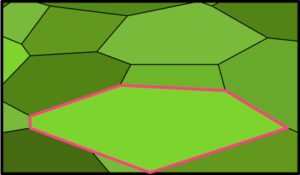High Impact Tutoring Built By Math Experts
Personalized standards-aligned one-on-one math tutoring for schools and districts
Polygons
Here you will learn about polygons, including types of polygons and how to classify them.
Students first learn about polygons as part of their work in geometry in 2nd and 3rd grade.
What are polygons?
Polygons are enclosed 2D shapes with straight sides. Two sides of a polygon meet at a vertex. 2D polygons are flat, meaning they are plane figures.
Here is an example of a polygon:

Polygons have interior angles and exterior angles.

Types of polygons
The table gives the names of various polygon with their number of sides.
| Polygon | Shape | Number of sides |
|---|---|---|
| Triangle |  | 3 |
| Quadrilateral | 4 | |
| Pentagon |  | 5 |
| Hexagon |  | 6 |
| Heptagon |  | 7 |
| Octagon |  | 8 |
| Nonagon |  | 9 |
| Decagon |  | 10 |
| Hendecagon |  | 11 |
| Dodecagon |  | 12 |
![[FREE] 2D Shape Worksheet (Grade 2 to 4)](https://thirdspacelearning.com/wp-content/uploads/2023/07/2D-shapes-check-for-understanding-quiz-listing-image.png)
[FREE] 2D Shape Worksheet (Grade 2 to 4)
![[FREE] 2D Shape Worksheet (Grade 2 to 4)](https://thirdspacelearning.com/wp-content/uploads/2023/07/2D-shapes-check-for-understanding-quiz-listing-image.png)
Use this quiz to check your grade 2 – 4 students’ understanding of 2D shape. 10+ questions with answers covering a range of 2nd, 3rd and 4th grade 2D shape topics to identify areas of strength and support!
DOWNLOAD FREE![[FREE] 2D Shape Worksheet (Grade 2 to 4)](https://thirdspacelearning.com/wp-content/uploads/2023/07/2D-shapes-check-for-understanding-quiz-listing-image.png)
[FREE] 2D Shape Worksheet (Grade 2 to 4)
![[FREE] 2D Shape Worksheet (Grade 2 to 4)](https://thirdspacelearning.com/wp-content/uploads/2023/07/2D-shapes-check-for-understanding-quiz-listing-image.png)
Use this quiz to check your grade 2 – 4 students’ understanding of 2D shape. 10+ questions with answers covering a range of 2nd, 3rd and 4th grade 2D shape topics to identify areas of strength and support!
DOWNLOAD FREEHow to classify polygons
Polygons can be regular or irregular.
| Regular polygons: | Irregular polygons: |
|---|---|
● All the sides are the same length.  | ● All the sides are not the same length.  |
Polygons can be convex or concave.
| Convex polygons: | Concave polygons: |
|---|---|
● Have interior angles that are acute,  | ● Have at least one interior angle that  |
What are polygons?

Common Core State Standards
How does this apply to second and third grade math?
- Grade 2 – Geometry (2.G.A.1):
Recognize and draw shapes having specified attributes, such as a given number of angles or a given number of equal faces. Identify triangles, quadrilaterals, pentagons, hexagons, and cubes.
- Grade 3 – Geometry (3.G.A.1):
Understand that shapes in different categories (example, rhombuses, rectangles, and others) may share attributes (example, having four sides), and that the shared attributes can define a larger category (example, quadrilaterals).
Recognize rhombuses, rectangles, and squares as examples of quadrilaterals, and draw examples of quadrilaterals that do not belong to any of these subcategories.
How to classify a polygon
In order to classify a polygon:
- State the number of sides.
- Recall the definition.
- Classify the polygon.
Polygons examples
Example 1: classify the shape by sides and regular or irregular
Name the type of polygon.

- State the number of sides.

The polygon has 6 sides.
2Recall the definition.
A regular polygon has sides that are the same length and angles that are the same size.
An irregular polygon has sides that are not the same length and angles that are the same size.

The sides are the same size which means they are equal (congruent).
The angles are the same measure which means they are equal (congruent).
3Classify the polygon.
The polygon is a regular hexagon.
Example 2: classify the shape by sides and regular or irregular
Name the type of polygon.

State the number of sides.

Recall the definition.
A regular polygon has sides that are the same length and angles that are the same size.
An irregular polygon has sides that are not the same length and angles that are the same size.

The angles are all equal because they are all 90^{\circ} .
The sides are not the same measure, which means they are not equal (congruent).
Classify the polygon.
The polygon appears to be a rectangle, which is an irregular quadrilateral.
Example 3: classify the shape by sides and regular or irregular
Name the type of polygon.

State the number of sides.

Recall the definition.
A regular polygon has sides that are the same length and angles that are the same size.
An irregular polygon has sides that are not the same length and angles that are the same size.

The sides are different lengths, so they are not equal (congruent).
The angles are different measures, so they are not equal (congruent).
Classify the polygon.
The polygon is an irregular pentagon.
Example 4: classify the shape by sides and regular or irregular
Name the type of polygon.

State the number of sides.

Recall the definition.
A regular polygon has sides that are the same length and angles that are the same size.
An irregular polygon has sides that are not the same length and angles that are the same size.

The sides are the same length (congruent) and the angles are the same measure (congruent).
Classify the polygon.
The polygon is a regular octagon.
Example 5: classify the shape by sides and regular or irregular
Here is a picture of Mary’s fenced in yard. Describe the polygon it makes.

State the number of sides.

4 sided polygon.
Recall the definition.
A regular polygon has sides that are the same length and angles that are the same size.
An irregular polygon has sides that are not the same length and angles that are the same size.

The angels are all different sizes.
The sides are all different sizes.
Classify the polygon.
Mary’s yard is an irregular quadrilateral.
Example 6: classify the shape by sides and regular or irregular
Describe the polygon that is made by the baseball field.

State the number of sides.

6 sides
Recall the definition.
A regular polygon has sides that are the same length and angles that are the same size.
An irregular polygon has sides that are not the same length and angles that are the same size.

The angles are not all equal to each other.
The sides are not all equal to each other.
Classify the polygon.
The baseball field is an irregular hexagon.
Teaching tips for polygons
- Incorporate learning activities that provide students with the opportunity to draw out the polygons so that they can formulate their own understanding.
- Include cross curricular art activities so students can be creative with polygons.
- Provide opportunities for students to see polygons in a real-life setting through architecture.
- Although worksheets have their place in the classroom, having students practice skills through interactive digital platforms and game playing is more motivating and engaging.
Easy mistakes to make
- Thinking that polygons with any equal angles and sides are regular
Regular polygons have all sides and angles that are the same size and equal.
For example,
A square is a regular polygon, and a trapezoid is an irregular polygon, even though the trapezoid has some angles that are the same size and some sides that are the same size.
Related 2D shape lessons
Practice polygons questions
1. Select the polygon that is a hexagon.








Hexagons are polygons with 6 sides. This was the only polygon choice with 6 sides.

2. Select the polygon that is an octagon.








An octagon is a polygon that has 8 sides.
This is the only polygon with 8 sides.

3. Which polygon is a regular pentagon?








A regular pentagon has 5 sides that are the same size and 5 angles that are the same size.

4. Which polygon is a regular quadrilateral?








A regular quadrilateral is a 4 sided polygon that has 4 equal sides and 4 equal angles. A square is a regular quadrilateral.

5. Which polygon best describes this field?

Regular pentagon

Regular hexagon

Irregular pentagon

Irregular hexagon

The field has six sides.

Six sided polygons are hexagons. The hexagon is also an irregular polygon. So the field is an irregular hexagon.
6. Which polygon best describes the yard?

Irregular triangle

Equilateral triangle

Rhombus

Quadrilateral

The yard has 3 sides so it is a triangle. The sides angles are not all the same size.

Polygons FAQs
A pentagram is a star which can be seen as a complex polygon made up of one pentagon and 5 triangles.
Diagonals are line segments connecting non-consecutive vertices of the polygons. The example below shows a parallelogram with one of its diagonals. There are several geometry theorems that you will learn in high school that describe properties of diagonals of certain polygons. 
There are some simple names for polygons like pentagons, hexagons, etc., but not all polygons have simple names. The term n -gon is used for polygons without simple names where n represents the number of sides (n sides). For example, a 22 -gon is a polygon with 22 sides. It’s proper name is an icosikaidigon!
The next lessons are
Still stuck?
At Third Space Learning, we specialize in helping teachers and school leaders to provide personalized math support for more of their students through high-quality, online one-on-one math tutoring delivered by subject experts.
Each week, our tutors support thousands of students who are at risk of not meeting their grade-level expectations, and help accelerate their progress and boost their confidence.

Find out how we can help your students achieve success with our math tutoring programs.
[FREE] Common Core Practice Tests (3rd to 8th Grade)
Prepare for math tests in your state with these 3rd Grade to 8th Grade practice assessments for Common Core and state equivalents.
Get your 6 multiple choice practice tests with detailed answers to support test prep, created by US math teachers for US math teachers!


